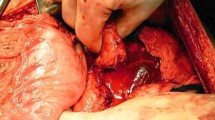Abstract
Purpose
Penetrating pancreatic injuries in children are uncommon and are not well described in the literature. We report a multi-institutional experience with penetrating pancreatic injuries in children.
Methods
A retrospective review of children sustaining penetrating pancreatic injuries was performed at eight pediatric trauma centers.
Results
Sixteen patients were identified. Eleven patients were male; (mean ± SE) age was 11.7 ± 1.2 years. The mechanism of injury was gun-shot wound in 14 patients and mean injury-severity score was 18 ± 3. All patients had associated injuries, most frequently small bowel injuries (n = 9). Patients had either grade I (n = 4), grade II (n = 7), or grade III (n = 4) injuries; there was a single grade V injury. All patients underwent exploratory celiotomy. Drainage of the injured pancreas was performed in 11 patients, and 2 patients underwent pancreatorrhaphy in addition to drainage; 3 underwent resection for grade III (n = 2) and grade V (n = 1) injuries. Thirteen patients required other intra-abdominal procedures. All patients required intensive care over a mean 11.0 ± 3.0 days. Mean duration of stay was 30.1 ± 5.6 days. Post-operative morbidity was 62.5 % with no mortalities.
Conclusions
Penetrating pancreatic injuries in children are uncommon and most often due to firearms. There is a high association with other injuries particularly hollow viscous perforation.
Similar content being viewed by others
References
Arkovitz MS, Johnson N, Garcia VF (1997) Pancreatic trauma in children: mechanisms of injury. J Trauma 42:49–53
Shilyansky J, Sena LM, Kreller M et al (1998) Nonoperative management of pancreatic injuries in children. J Pediatr Surg 33:343–349
Keller MS, Stafford PW, Vane DW (1997) Conservative management of pancreatic trauma in children. J Trauma 42:1097–1100
Stawicki SP, Schwab CW (2008) Pancreatic trauma: demographics, diagnosis, and management. Am Surg 74:1133–1145
Schroeppel TJ, Croce MA (2007) Diagnosis and management of blunt abdominal solid organ injury. Curr Opin Crit Care 13:399–404
Vasquez JC, Coimbra R, Hoyt DB, Fortlage D (2001) Management of penetrating pancreatic trauma: an 11-year experience of a level-1 trauma center. Injury Int J Care Inj 32:753–759
Young PR Jr, Meredith JW, Baker CC, Thomason MH, Chang MC (1998) Pancreatic injuries resulting from penetrating trauma: a multi-institution review. Am Surg 64:838–843
Ivatury RR, Nallathambi M, Rao P, Stahl WM (1990) Penetrating pancreatic injuries. Analysis of 103 consecutive cases. Am Surg 56:90–95
Sorensen VJ, Obeid FN, Horst HM, Bivins BA (1986) Penetrating pancreatic injuries, 1978–1983. Am Surg 52:354–358
Moore EE, Cogbill TH, Malangoni MA et al (1990) Organ injury scaling II: pancreas, duodenum, small bowel, colon, and rectum. J Trauma 30:1427–1429
Nadler EP, Gardner M, Schall LC, Lynch JM, Ford HR (1999) Management of blunt pancreatic injury in children. J Trauma 47:1098–1103
Wales PW, Shuckett B, Kim PCW (2001) Long-term outcome after non-operative management of complete pancreatic transection in children. J Pediatr Surg 36:823–827
Bass J, Di Lorenzo M, Desjardins JG et al (1988) Blunt pancreatic injuries in children: the role of percutaneous external drainage in the treatment of pancreatic pseudocysts. J Pediatr Surg 23:721–724
Wood JH, Partrick DA, Bruny JL et al (2010) Operative vs nonoperative management of blunt pancreatic trauma in children. J Pediatr Surg 45:401–406
Paul MD, Mooney DP (2011) The management of pancreatic injuries in children: operate or observe. J Pediatr Surg 46:1140–1143
Iqbal CW, St. Peter SD, Tsao K et al (2014) Operative versus non-operative management for blunt pancreatic transection in children: multi-institutional outcomes. J Am Coll Surg 218:157–162
Conflict of interest
The authors declare they have no conflict of interest to disclose.
Author information
Authors and Affiliations
Corresponding author
Rights and permissions
About this article
Cite this article
Alemayehu, H., Tsao, K., Wulkan, M.L. et al. Multi-institutional experience with penetrating pancreatic injuries in children. Pediatr Surg Int 30, 1107–1110 (2014). https://doi.org/10.1007/s00383-014-3599-2
Accepted:
Published:
Issue Date:
DOI: https://doi.org/10.1007/s00383-014-3599-2




